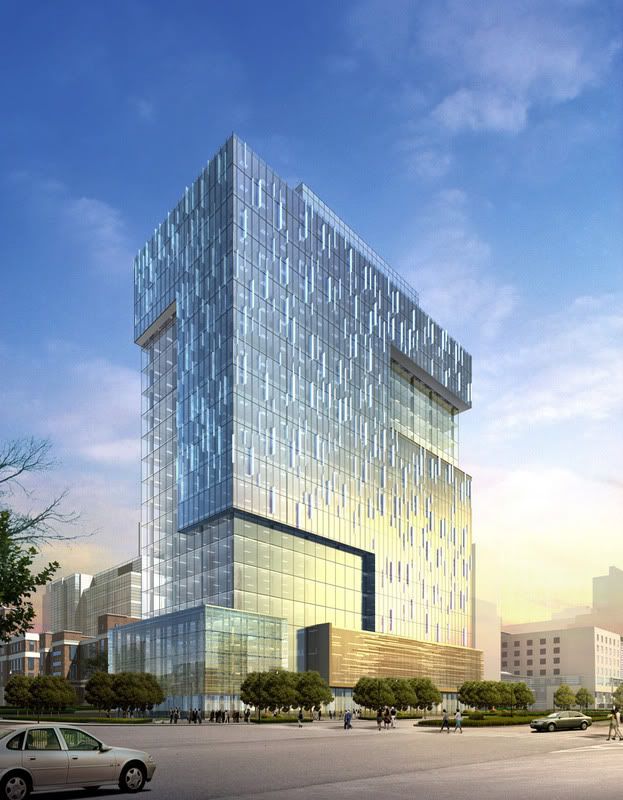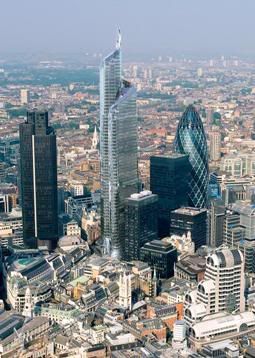http://www.guardian.co.uk/artanddesign/2008/nov/17/architecture-recession-credit-crunch
Frozen skyline
In the last recession, 40% of architects lost their jobs. Are they prepared for this one? And how will the crunch affect our once-booming cityscapes? By Jonathan Glancey
Jonathan Glancey
The Guardian, Monday 17 November 2008
Article history
'I didn't lose any work in the first recession I experienced," says Zaha Hadid, "because I didn't have any work." This was the early 1970s, the time of the three-day week, when the lights of Great Britain Ltd appeared to be switching off for good. "I was drawing with freezing cold hands in rooms lit by candles. It seems almost unbelievable now. If I learned something, it was that anything can happen. We're doing well today, but this is partly because so many of our projects are in places like Dubai, which seem immune from recession. But you never know."
You certainly don't. Last week, Frank Gehry's first major project in Britain was ditched, making it the first big victim, architecturally, of the credit crunch. Plans for a dramatic development of 750 flats facing the sea at Brighton were dropped when the developer, Karis, failed to find fresh funds, three months after Dutch bank ING pulled out. If Gehry - creator of the famous "Bilbao effect", by which thrilling architecture triggers urban regeneration - can be tossed aside by recession-wary banks, what about less celebrated architects?
"Housebuilders are in such a hurry to drop projects," says Amanda Baillieu, editor of Building Design magazine, "they're text-messaging architects to tell them to stop work. At the same time, banks are foreclosing on loans made to small architectural practices set up over the past few years, in the hope of cashing in on the housing boom. The prediction is that one in five will go bust."
Some 40% of architects lost their jobs in the last recession, says Sunand Prasad, president of the Royal Institute of British Architects. "It was very hard for young architects in the early 1990s. Luckily, architecture encourages broad thinking. Many found new careers in law, academia, catering and so on. But, when the good times came again in the lead-up to the millennium, it seemed an entire generation had gone missing. It took some time to find them again."
Older architects are no strangers to recession. The current slump, though, is likely to be very tough indeed. Why? Because in the past, the public sector - whether in Britain, continental Europe or the US - was able to step in when housebuilders and developers pulled in their horns. Take President Roosevelt's Tennessee Valley Authority. Between 1933 and 1944, some 16 magnificent dams with hydro-electric power stations were built along the river, giving thousands of jobs to architects, engineers and contractors, not to mention bringing irrigation, power and economic growth to the poor farming communities of seven southern states.
Today, not only is the TVA the biggest energy producer in the US, its mighty structures remain tourist attractions. Closer to home, the superb architectural and engineering work accomplished by the London Passenger Transport Board, a public corporation established in 1933, proved what could be achieved when the going was tough: extensions to the tube, new stations and rolling stock. Such work was inspiring; it also created many jobs.
Today, though, the public sector in Britain has increasingly been privatised. Schemes such as PFI and PPP - private finance initiative and public-private partnerships, which fund new public buildings, especially hospitals and schools, and the renovation of the London underground - have turned out to be as ill-conceived as critics said they would be a decade ago. With banks and markets floundering, public projects are feeling the squeeze, and there is certainly nothing around the corner as grand and bold as Roosevelt's awe-inspiring TVA.
"About three-quarters of our work is in the public sector," says John Pringle of Pringle Richards Sharratt, architects of the Millennium Galleries, Sheffield. "But, as we can't be sure what will happen to PFI and PPP, we can't rest easy. I feel for the many young practices that were hoping to design intelligent new housing. Aside from the sudden fall-off in work, they're up against new layers of bureaucracy." Pringle is referring to increasingly complex building contracts and the rocketing numbers of quangos and regeneration agencies poking their noses into the business of architecture. The simple client-architect relationship of yore - there's a building I need and I'd like you to design it - has been buried beneath jargon-laced red tape.
"The bureaucracy is bloody awful," says Will Alsop. "To get jobs beyond house extensions, young architectural practices have to show satisfactory accounts for the past three or four years to prove they're a safe pair of hands. How the hell are they going to be able to do that during a recession? There wasn't any work at home when I set up in the late 1970s. We went to Germany and got some good work without anyone asking us about our finances - zilch! - or even our track record. What the Germans wanted was imaginative new architecture."
In times of recession, architects may well need to follow commissions around the world. "If I tell you we've got work in 22 countries," says Norman Foster, "it's not to brag, but to underline how you can only really beat a slump - unless you're a one-man band with minimal overheads - if you have commissions spread internationally. Foster and Partners is not 100% recession-proof, but we've always been prepared to go where the work is. Today, we're also known as urban planners and product designers, so we're not hostage to sudden drops in the building market. We were lucky to win the commission to design the Hong Kong and Shanghai Bank headquarters in 1979, when there was little work at home. In fact, this was about the only job in the office. So we gave it our all."
This building, one of Foster's finest, opened in 1986, when the British economy was beginning to pick up. It stood Foster and his team in good stead, setting a new standard for corporate HQ. Foster has never looked back. In a curious way, the recession served him well.
Yet, as Nigel Coates, professor of architecture at the Royal College of Art, tells his students: "You don't choose architecture for the money. You should only do it if you love the idea of being an architect. But I've also been saying that recession isn't altogether a bad thing. Of course, I don't want people to lose their jobs, but there's been a lot of boring and plain bad new building during the boom years - frumpitecture, I call it. Young architects are unlikely to find an interesting job, or any job, in the coming months, so it's a good time for them to study, think and dream of what a next generation of architecture might be."
What might post-recession architecture be like? Alison Brooks, an architect whose practice shared the 2008 Stirling prize for the design of the much-feted Accordia housing development in Cambridge, says: "So much housing raced up in recent years has been mean and transitory. No one wants to lay down roots in homes that are pokey, fast-buck products. What's the point of building houses no one really wants just because they're low cost and meet official targets?"
A new housing scheme Brooks designed at Newhall, Essex, shows what might be done. It is a fine balance of modesty and ambition, modernity and tradition. Timber-framed family houses, with generous rooms, offer a fresh take on traditional local styles. They use every square inch: roof spaces are family dens, while courtyard gardens are like outside rooms. As for energy conservation, they meet current guidelines, or even exceed them.
Indeed, what we may see is a swing towards a less showy architecture, with invention squeezed into pint pots. Some of Christopher Wren's most inspired buildings, after all, were the gem-like City of London churches he built around St Paul's. Clamber up the steps of St Stephen Walbrook and, behind modest ragstone walls, you find yourself beneath a magnificent dome that might belong to one of the great baroque churches of Venice. Or visit Le Corbusier's Petit Cabanon and see how a tiny building can be highly charged. "I have a chateau on the Côte d'Azur," he wrote to a friend. "It's for my wife. It's extravagant in comfort and gentleness." It is less than four metres square.
The years following the Wall Street Crash saw in "Depression deco", a sort of late-flowering art deco. While we might not see anything as distinct as that, we could yet discover a likable new modesty: offices gathered around courtyards with rooftop gardens, rather than look-at-me skyscrapers; supermarkets dug underground rather than swaggering over historic towns; schools doubling as performing arts centres. And, if the Olympic Delivery Authority cares to take up the offer of a low-cost, take-apart sports building, as suggested by Dipesh Patel, a director of Arup Associates, we may yet see the 2012 Games proving that swanky buildings are not the only way of going for gold.
Still, if you happen to be an architect hooked on wildly adventurous design and are willing to travel (and work competitively), then Dubai, Abu Dhabi, India, Russia and South America beckon. In Britain, meanwhile, the recession, while painful, might spark fresh debate and instill new ideas, readying us for the next building boom when the money flows again.






